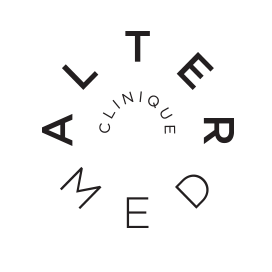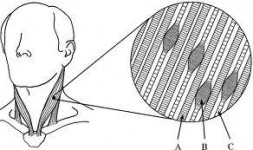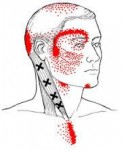Montreal masso-kinesitherapy
What is a trigger point ?
Trigger points are hyper-irritated points that can be found in any skeletal muscle in the body. These points can be palpated in tight muscle fibers and can radiate pain in a predictable pattern.
Because of this referred pain, it often happens that the source of pain suffered by patients is misdiagnosed or treated with little chance of success.

Ex: John comes to the clinic with abdominal pain that radiates down the side and back of the leg, sometimes around the knee and into the calf.
This pain pattern is related to sciatica and trigger points present in the gluteus medius muscle.
Trigger points can be active or latent. Active trigger points cause local and/or radiating pain, while latent trigger points are only painful when palpated and do not radiate. There is always a risk that latent trigger points will become active.
Do I have trigger points?
Generally, most people have trigger points, which, if not active, are latent.
Several factors can be responsible for the activation of these trigger points:
- Acute or chronic muscle overload
- Their activation by another trigger point
- A sickness
- A homeostatic imbalance
- Direct trauma to the area
- A traumatic accident (such as a car accident in which the muscles were overstretched)
Due to the many occupations that require sitting for eight hours a day, poor posture, inactivity, etc., muscle imbalances are becoming more common. This state of muscle imbalance provides an ideal environment for the formation and activation of trigger points.
How are trigger points treated ?
Direct ischemic pressure, combined with active and passive stretching techniques and local application of heat to encourage circulation, is an effective approach to treating trigger points.
It is very rare that I treat a patient without encountering at least a few trigger points. Although trigger point work can be painful at times, most patients describe it as “pain that feels good” or “good pain” and come back with a specific request to be treated with this technique again.
What should I expect when I receive treatment?
At Clinique Altermed, a typical trigger point treatment with my approach begins with an assessment of the patient. This allows me to identify problem areas and trigger points that may need to be worked on.
Once the assessment is complete, you sit on the treatment table, as you would for a massage. The treatment of trigger points can be done while remaining fully clothed; however, it is most effective when applied directly to the skin. I often combine deep tissue massage, myofascial release, hydrotherapy (heating wet compress) and offer stretching techniques to complement my trigger point work.
Once the treatment is complete, I show the stretches that can be done and how often they should be done to help prevent the trigger point from coming back.

Treatment of a trigger point can, in some cases, cause muscle soreness (which is similar to what one may feel after physical training) that can last between 24 and 72 hours, and often requires several sessions to obtain the best results.
For more information, please contact Daniel Godin at Clinique Altermed.




